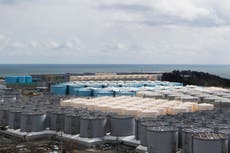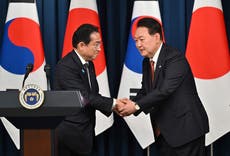Drink Fukushima water if it’s clean, South Korea tells Japanese officials
Millions of tonnes of treated radioactive water release will begin between spring and summer
Your support helps us to tell the story
From reproductive rights to climate change to Big Tech, The Independent is on the ground when the story is developing. Whether it's investigating the financials of Elon Musk's pro-Trump PAC or producing our latest documentary, 'The A Word', which shines a light on the American women fighting for reproductive rights, we know how important it is to parse out the facts from the messaging.
At such a critical moment in US history, we need reporters on the ground. Your donation allows us to keep sending journalists to speak to both sides of the story.
The Independent is trusted by Americans across the entire political spectrum. And unlike many other quality news outlets, we choose not to lock Americans out of our reporting and analysis with paywalls. We believe quality journalism should be available to everyone, paid for by those who can afford it.
Your support makes all the difference.South Korea’s opposition leader has challenged Japanese officials to drink treated radioactive water from the destroyed Fukushima nuclear power plant amid concerns over Tokyo’s plan to release the water into the sea.
Lee Jae-myung, the leader of the Democratic Party of Korea, implored Japanese officials to make good on their claims that the radioactive water is filtered and safe to be released into the sea.
There are fierce protests from local fishing communities as well as neighbouring countries such as South Korea, China, and the Pacific Island nations following concerns over the consequences of releasing the water.
Last week, Japanese and South Korean officials held a nearly 12-hour long meeting and agreed to have a four-day visit by a Seoul delegation to the Fukushima nuclear plant to evaluate the water from the tsunami-wrecked Fukushima Daiichi nuclear plant.
It was after president Yoon Suk-Yeol held a rare summit with Japanese prime minister Fumio Kishida in Seoul earlier this month and the two leaders agreed to an expert visit next week to inspect the plans.
“Japan is putting forward claims that the contaminated water from the Fukushima nuclear power plant, if treated, is safe enough to drink,” Mr Lee said on Monday. “If it is safe enough to drink, they should use it as drinking water.”
He added that the water should be at least fit for agricultural or industrial use as millions of tonnes of water released in the sea will be used by people.
His Democratic Party of Korea has been opposing the expert delegation visit, raising fears that the trip could be used to justify the plans to release the water in what will be the Yoon administration’s efforts in his bid to mend ties with Tokyo.
“The Japanese government’s attitude makes it clear that the inspection team the government is sending is only a formality to justify its plan to discharge contaminated water,” the party’s spokesperson Park Sung-joon said last week.
In 2011, a massive earthquake and tsunami destroyed the Fukushima Daiichi plant’s cooling systems, causing the reactors to release large amounts of radiation.
The plant produces 100 cubic metres of contaminated water, containing a mixture of groundwater, seawater and water used to keep the three damaged reactor cores cool, every day. The water is filtered out of radioactive material and stored in tanks.
The Japanese government and the plant’s operator, Tokyo Electric Power Company Holdings, said the water release will begin between spring and summer and take decades to finish.
Japan has said it has more than 1.3 million cubic metres and needs to release the water as space is running out.




Join our commenting forum
Join thought-provoking conversations, follow other Independent readers and see their replies
Comments